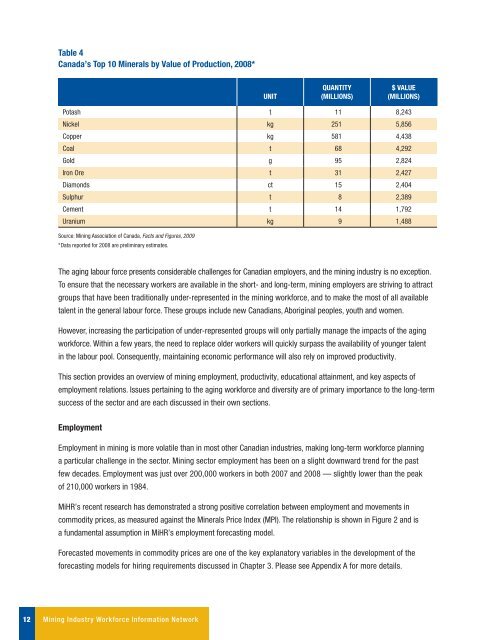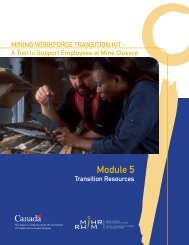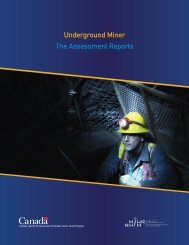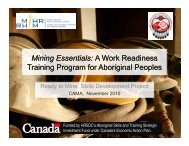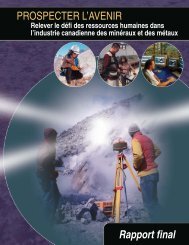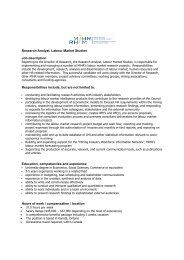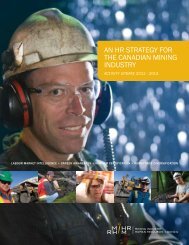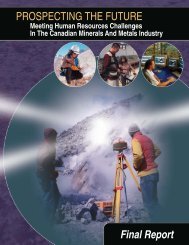Canadian Mining Industry Employment and Hiring Forecasts - MiHR
Canadian Mining Industry Employment and Hiring Forecasts - MiHR
Canadian Mining Industry Employment and Hiring Forecasts - MiHR
Create successful ePaper yourself
Turn your PDF publications into a flip-book with our unique Google optimized e-Paper software.
Table 4<br />
Canada’s Top 10 Minerals by Value of Production, 2008*<br />
UNIT<br />
QUANTITY<br />
(MILLIONS)<br />
$ VALUE<br />
(MILLIONS)<br />
Potash t 11 8,243<br />
Nickel kg 251 5,856<br />
Copper kg 581 4,438<br />
Coal t 68 4,292<br />
Gold g 95 2,824<br />
Iron Ore t 31 2,427<br />
Diamonds ct 15 2,404<br />
Sulphur t 8 2,389<br />
Cement t 14 1,792<br />
Uranium kg 9 1,488<br />
Source: <strong>Mining</strong> Association of Canada, Facts <strong>and</strong> Figures, 2009<br />
* Data reported for 2008 are preliminary estimates.<br />
The aging labour force presents considerable challenges for <strong>Canadian</strong> employers, <strong>and</strong> the mining industry is no exception.<br />
To ensure that the necessary workers are available in the short- <strong>and</strong> long-term, mining employers are striving to attract<br />
groups that have been traditionally under-represented in the mining workforce, <strong>and</strong> to make the most of all available<br />
talent in the general labour force. These groups include new <strong>Canadian</strong>s, Aboriginal peoples, youth <strong>and</strong> women.<br />
However, increasing the participation of under-represented groups will only partially manage the impacts of the aging<br />
workforce. Within a few years, the need to replace older workers will quickly surpass the availability of younger talent<br />
in the labour pool. Consequently, maintaining economic performance will also rely on improved productivity.<br />
This section provides an overview of mining employment, productivity, educational attainment, <strong>and</strong> key aspects of<br />
employment relations. Issues pertaining to the aging workforce <strong>and</strong> diversity are of primary importance to the long-term<br />
success of the sector <strong>and</strong> are each discussed in their own sections.<br />
<strong>Employment</strong><br />
<strong>Employment</strong> in mining is more volatile than in most other <strong>Canadian</strong> industries, making long-term workforce planning<br />
a particular challenge in the sector. <strong>Mining</strong> sector employment has been on a slight downward trend for the past<br />
few decades. <strong>Employment</strong> was just over 200,000 workers in both 2007 <strong>and</strong> 2008 — slightly lower than the peak<br />
of 210,000 workers in 1984.<br />
<strong>MiHR</strong>’s recent research has demonstrated a strong positive correlation between employment <strong>and</strong> movements in<br />
commodity prices, as measured against the Minerals Price Index (MPI). The relationship is shown in Figure 2 <strong>and</strong> is<br />
a fundamental assumption in <strong>MiHR</strong>’s employment forecasting model.<br />
Forecasted movements in commodity prices are one of the key explanatory variables in the development of the<br />
forecasting models for hiring requirements discussed in Chapter 3. Please see Appendix A for more details.<br />
12 <strong>Mining</strong> <strong>Industry</strong> Workforce Information Network


